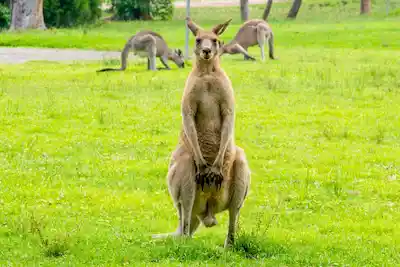Why Male Kangaroos Lack Pouches
Have you ever wondered if male kangaroos have pouches like their female counterparts? It's a common misconception that all kangaroos sport these unique marsupial features. While many are familiar with the iconic image of a joey peeking out from its mother's pouch, the truth about male kangaroos may surprise you.
This article will delve into the fascinating world of kangaroo anatomy, unraveling why only female kangaroos possess pouches and what this means for their role in the animal kingdom.
Male kangaroos do not have pouches. While all kangaroos are born without pouches, only female kangaroos develop them as they mature. This pouch, a crucial feature for nurturing their young, begins forming in the early months after birth and continues to develop until the joey is weaned.

Why Don't Male Kangaroos Have a Pouch?
In most kangaroo species, males and females do not form lasting bonds after mating. After birth the newborn joey climbs from the birth canal into the mother's pouch, where it latches onto a teat for several months, receiving essential nutrients from her milk.
Male kangaroos lack teats and cannot produce milk, making a pouch unnecessary. Without the ability to feed or carry the young, male kangaroos do not develop pouches.
When a young kangaroo first leaves the pouch, it is already relatively independent and gains no significant advantage from a male pouch. Joeys leave the mother’s pouch when they are able to move on their own. They remain close to the mother, hopping back into the pouch if danger arises.
A female kangaroo only gives birth when her pouch is vacant, ensuring only one joey occupies the pouch at a time. Male kangaroos can mate with multiple females, but there's only room for one joey in a pouch, making it impractical for males to have one. Consequently, caring for joeys is solely the mother's responsibility, which is why male kangaroos do not have pouches.
What Body Parts Do Male Kangaroos Have Instead?

Male kangaroos do not have a pouch, meaning there is no opening in the abdominal area. Instead, their testicles are visible externally, making them easy to identify. This visible trait, along with their larger body size, helps distinguish males from females. To learn more about the reproductive anatomy of kangaroos, read this article.
Are There Any Male Marsupials with Pouches?
Out of the 320 species of marsupials found mainly in Australia, America, and parts of Asia, such as kangaroos, quokkas, wallabies, opossums, koalas, and Tasmanian devils, almost all male marsupials do not have pouches. The reason is consistent across marsupials: newborns are underdeveloped fetuses requiring the protection, warmth, and nourishment provided by the mother's pouch.
An exception is the water opossum, whose males have a less distinct pouch that covers the testicles, serving a different purpose unrelated to caring for the young.
Conclusion
In summary, male kangaroos do not have pouches because they are not involved in nurturing the young. The responsibility of caring for joeys falls entirely on female kangaroos, who develop pouches to provide their offspring with the necessary warmth, protection, and nourishment. This characteristic is common among marsupials, with few exceptions, such as the water opossum, where the male’s pouch serves a different purpose. Understanding these distinctions highlights the fascinating adaptations and roles within the diverse group of marsupials.


